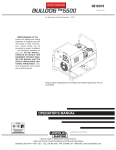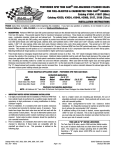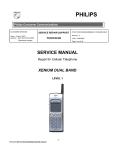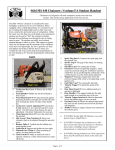Download Edelbrock 1602 Automobile Parts User Manual
Transcript
PERFORMER™ CYLINDER HEADS For 1984 & Later Harley-Davidson® Evolution® “Big Twin” Engines Catalog #s 1602 & 1615 INSTALLATION INSTRUCTIONS PLEASE study these instructions carefully before beginning this installation. Most installations can be accomplished with common tools and procedures. However, you should be familiar with and comfortable working on your vehicle. If you do not feel comfortable performing this installation, it is recommended to have the installation completed by a qualified mechanic. If you have any questions, please call our Technical Hotline at: 1-800-416-8628, 7:00 am - 5:00 pm, Pacific Standard Time, Monday through Friday or e-mail us at [email protected]. If your question is motorcycle carburetor-related, please call our Edelbrock Motorcycle Carburetor division at 1-877-888-7504, Ext. 2. IMPORTANT NOTE: Proper installation is the responsibility of the installer. Improper installation will void your warranty and may result in poor performance and engine or vehicle damage. PLEASE complete and mail your warranty card. Be sure to write the model number of this product in the "Part #____" space. THANK YOU. DESCRIPTION: The Edelbrock Performer™ Cylinder Heads are designed for street high performance use, and are interchangeable with stock HarleyDavidson® cylinder heads on the Evolution® “Big Twin” engines. Edelbrock Performer™ heads can be used with unmodified, stock pistons and the stock valve train with cam lifts up to .580" for bolt-on performance. These heads make excellent power increases in the stock RPM range of the HarleyDavidson® Big Twin® engine (idle to 5500 rpm). Cam lifts higher than .580" or engine speeds higher than 5500 rpm will require different valve springs and other valve train modifications - please consult a qualified performance mechanic. These heads will work with bore sizes up to 3-13/16" and feature a rectangular shaped intake port for a noticeable increase in air flow. This .125" raised rectangular intake port also helps to increase the velocity of the incoming air for more power. Edelbrock intake manifolds must be used with these heads due to the unique port shape (see application chart below). The dual-quench combustion chamber features a revolutionary new design that directs the air/fuel mixture into a tumbling and swirling motion for a better mix and more efficient combustion. The 72cc combustion chamber increases the compression ratio to 9.5:1 for more power. The “D” shaped exhaust port provides a larger area for increased flow, and was designed to create a mis-match between the exhaust pipe and the exit which reduces power-robbing exhaust reversion. Performer™ heads fit 1984 and later Evolution® "Big Twin" engines. They are machined with 1992 and later crankcase breather holes, and include block-off plugs for use on 1984-1991 engines. Performer™ cylinder heads are assembled with stainless steel valves (1.850" intake and 1.610" exhaust), ductile iron valve seats and guides, 1.460" O.D. heavy-duty valve springs, teflon valve stem seals, and machined valve spring retainers and locks. They are cast out of 356 aluminum and heat treated to T-6 specs. INTAKE MANIFOLD APPLICATION CHART - Performer™ Cylinder Heads Cyl. Length stock (80") stock -.050" -.175" +.015" +.075" S&S Kit -89" 93" 88" 96" 98" 3-Piece Flange Intake #1671 #1671 #1676 #3031 #1671 #1674 3-Piece Spigot Intake #1670 #1670 #1677 #3030 #1670 #1675 3-Piece S&S “G” Intake #1669 #1669 #1683 #3032 #1669 #1684 IMPORTANT NOTES BEFORE BEGINNING INSTALLATION • It is recommended that the installation of Performer cylinder heads be performed by a qualified engine builder with experience in high performance or racing modifications to Harley-Davidson® engines. • If you are using any cam other than stock or Edelbrock Performer-Plus cam #1740, it is mandatory that valve-to-valve clearance is checked to determine if these heads are compatible with the camshaft you intend to run. See Page 2. The words Evolution, Harley and Harley-Davidson are registered trademarks of Harley-Davidson, Inc., Milwaukee, Wisconsin, USA and are used in this instruction sheet for reference only. Catalog #1602, 1615 Rev. 4/06 - RS/mc Edelbrock is a registered trademark of Edelbrock Corp, Torrance, CA, USA. Page 1 of 6 ©2006 Edelbrock Corporation Brochure #63-1602 CHECKING VALVE-TO-VALVE CLEARANCE 1. 2. 3. 4. Before installing heads on engine, remove valve springs, retainers and locks from one head. Leave the valve seals on to hold the valves in position during the clearance check. Use a 6" caliper to measure valve tip height from the valve spring pocket. Find the cam manufacturer’s "Valve lift at Top Dead Center" specs and subtract this dimension from the valve tip height you measured in step 2. Using the calipers to check the new valve tip height, open the valve by the amount calculated in step 3. 5. 6. Repeat this process for the other valve. Note that intake and exhaust "Valve lift at Top Dead Center" dimensions are usually different. With both intake and exhaust valves open to the correct specifications, use a .060" feeler gauge to check clearance between the valve heads. If less than .060" clearance exists, you run the risk of valves hitting during engine operation, voiding any warranty on these cylinder heads. If there is less than .060" clearance, select another cam for your engine. DISASSEMBLY WARNING To avoid accidental start-up of vehicle and possible personal injury, disconnect the battery cables (negative cable first) before performing any of the following procedures. 1. 2. 3. Remove seat. Remove instrument cover (FX/Softail and Dyna Glide models). Drain fuel tank. Disconnect fuel line and plug end of fuel line with 5/16" bolt. For split tanks use a 1/4" bolt and rubber cap to plug fuel line and opening. Disconnect any wires from tank. Remove fuel tank. WARNING Gasoline is flammable and fumes are explosive. To avoid possible personal injury, drain gasoline in well ventilated area away from fire or flame. Drain gasoline into approved gasoline container only. NOTE: FX/Softail Models An access hole has been provided through the frame to remove the left rear rocker box bolt. A rolled up paper tube should be inserted through the hole in the frame and around the bolt head during removal, to prevent accidentally dropping the bolt into the frame opening. 4. 5. 6. 7. 8. 9. 10. 11. 12. 13. 14. 15. 16. Remove upper cylinder head stabilizer from frame and cylinder head bracket. Do not loosen stabilizer jam nuts. On FXR model remove ignition switch. Remove spark plugs. On FLT models remove lower attaching bolts from right side footboard. Remove exhaust system. Remove air cleaner cover, filter element and back plate. Remove fuel and V.O.E.S. (Vacuum Operated Electric Switch) hoses from carburetor. Remove carburetor. Remove intake manifold flange screws and remove intake manifold. Support engine with small jack and piece of wood, then remove large center bolt from front engine mount. On some bikes, it may be necessary to remove ignition module first. Remove bolt from outer end of front stabilizer. Remove both front engine mount bolts and remove front engine mounting plate with stabilizers. Use the jack to raise and lower engine as needed for clearance. Catalog #1602, 1615 Rev. 4/06 - RS/mc Page 2 of 6 Figure 1 - Rocker Arm Cover Assembly. 1. 2. 3. 4. 5. 6. 7. 8. 9. 10. Bolt (4) Seal (4) Upper rocker arm cover Middle rocker arm cover Gasket Gasket Gasket Rocker arm shaft (2) Rocker arm Rocker arm 11. 12. 13. 14. 15. 16. 17. 18. 19. Bolt and washer (2) Bolt and washer (2) Bolt and washer (3) Bolt and washer (3) Gasket Gasket Lower rocker arm cover Umbrella valve Rocker arm bushing (4) ©2006 Edelbrock Corporation Brochure #63-1602 7. 1. 2. 3. 4. 5. 6. 7. 8. 9. 10. 11. 12. 13. 14. d15. Push rod (2) Spring cap retainer (2) Upper push rod cover (2) Spring cap (2) Spring (2) Spacer (2) O-ring (2) Lower push rod cover (2) O-ring (2) Spacer (2) O-ring (2) Tappet (2) Bolt (4) Lifter guide (2) Gasket (2) 8. 9. Remove the remaining fasteners (12, 13 and 14) holding the lower rocker arm cover (17) to the cylinder head (See Figure 1). Remove the lower rocker cover and gaskets (15 and 16). See Figure 4. Loosen each head bolt (1, 2) 1/8 turn following the cross pattern sequence shown in Figure 9. CAUTION Loosen head bolts gradually, in a cross pattern, to prevent distorting the head, cylinder and crankcase studs. 10. 11. 12. 13. Continue loosening in 1/8 turn increments until bolts are loose. Remove bolts. Remove cylinder head and head gasket. Repeat steps 1 through 14 for the other head. NOTE: It may be necessary to raise or lower endgine in frame for clearance. Use small jack under engine. Figure 2 - Pushrod and Cover Assembly REMOVE ROCKER ARM COVERS 1. Remove bolts (1) and seals (2) (See Figure 1). Use a shortened 3/16" allen wrench. 2. Remove top (3) and middle (4) sections of rocker box. Remove gaskets (5, 6, and 7) and discard. 3. Rotate the engine so both valves are closed on the head being removed. 4. Remove the rocker arm retaining bolts (11) and washers nearest the rocker arm shafts at the push rod end. NOTE: Remove lower rocker boxes as an assembly then disassemble if necessary. 5. 6. Remove the push rods (1) and mark their location and orientation, top and bottom (See Figure 2). Remove spring cap retainers (2) on push rod covers and remove push rod covers and associated parts (3 through 11) (See Figures 2 & 3). CAUTION All valve train components must be reinstalled in their original positions. Remove Spring Cap Retainers. Figure 4 - Cylinder Head and Cylinder 1. 2. 3. 4. 5. 6. 7. 8. 9. Head bolt, long (2) Head bolt, short (2) Cylinder head gasket Inner valve spring (2) Outer valve spring (2) Valve keeper (4) Upper collar (2) Lower collar (2) Valve (1) intake, (1) exhaust 10. 11. 12. 13. 14. 15. 16. 17. 18. Valve stem seal (2) Cylinder stud (4) Cylinder base gasket O-ring and insert (2) Valve guide (2) Valve seat (2) Cylinder head (2) Cylinder (2) Piston Figure 3 - Removing Spring Cap Retainers Catalog #1602, 1615 Rev. 4/06 - RS/mc Page 3 of 6 ©2006 Edelbrock Corporation Brochure #63-1602 INSTALLATION PROCEDURE HEAD GASKETS You must use the correct head gaskets to achieve a 9.5:1 compression ratio for best power. Thicker gaskets will lower compression and power, and thinner gaskets will raise compression higher than advisable for use with today's unleaded pump gasoline. 1. 2. Use Edelbrock gasket set #1640 for 1984-91 or #1641 for 1992 and later engines. This set includes the proper thickness head gaskets (.045") and the special intake manifold gaskets required for these cylinder heads. You may use standard Harley-Davidson® head gaskets, if desired. They vary in thickness, so it is advisable to measure your gasket before use (See Figure 5). Recommended thickness is .045". Figure 6 - Cleaning Gasket Surfaces CAUTION If you use copper head gaskets, be aware that they must be properly annealed prior to installation. Even if gaskets were annealed when new, copper can reharden during storage. Failure to anneal before installation may lead to head gasket failure. Figure 7 - Cylinder O-Rings and Inserts 1 Figure 5 - Measuring Cylinder Head Gasket Front cylinder CYLINDER HEAD INSTALLATION CAUTION Install new O-rings over the cylinder dowels before installing the head gasket. Install the O-rings first to ensure alignment of the head gasket and prevent gasket leaks. CAUTION Use only original equipment specification head bolts and other hardware. All original hardware is hardened grade 8 material, which is required for proper performance of these parts. 1. 2. 3 Be sure the gasket surfaces and stud holes are clean and dry (See Figure 6). Place new O-rings (13) on the cylinders and position the head gaskets on the inserts (13) (See Figure 7). Dip the head bolt threads and bottom face of bolt head in oil; then wipe off any excess. Install the head bolts (1 and 2, Figure 4) finger tight. 2 4 2 4 Rear cylinder 1 3 Figure 8 - Cylinder Head Bolt Torque Sequence Catalog #1602, 1615 Rev. 4/06 - RS/mc Page 4 of 6 ©2006 Edelbrock Corporation Brochure #63-1602 3. Cylinder Head bolt torque sequence (See Figure 8): The procedure for tightening the head bolts is extremely critical; not only to prevent gasket leaks, but to prevent stud failure and heads and cylinders distortion. CAUTION Be sure you thoroughly clean and lubricate the cylinder head bolts before tightening to the correct torque. Friction because of dirt or grime will cause the torque wrench readings to be incorrect. Clean and lubricate the threads with engine oil and screw the bolts onto the crankcase studs by hand to be sure there is no friction. Figure 9 - Tightening 1986-1995 Head Bolts A. Cylinder Head Torque Sequence for 1984-85 Models CAUTION Use only original equipment head bolts and studs for your year vehicle to ensure proper torque and head gasket life. 1. 2. 3. PUSH ROD INSTALLATION NOTE: There is one length push rod for each of four locations (See Figure 10). Be sure to color match each push rod to its correct valve and cam lobe; purple to rear exhaust; blue to rear intake; yellow to front intake; and green to front exhaust. See Figure 8. With a torque wrench, start at the cylinder head bolt numbered "1" and tighten to 7-9 ft./lbs. Then tighten "2", "3", and "4" in order to 7-9 ft./lbs. Following the torque sequence, tighten each bolt to 15-17 ft./lbs. Following the torque sequence, tighten each bolt to 24-26 ft./lbs. CAUTION The cylinder head bolts are not to be checked for tightness after final torquing at reassembly is completed. Retightening the bolts to specified torque at regular intervals will place undue stress on bolts and bolt anchoring threads. B. Cylinder Head Torque Sequence for 1986-95 Models CAUTION Use only original equipment head bolts and studs for your year vehicle to ensure proper torque and head gasket life. 1. 2. 3. See Figure 8. With a torque wrench, start at the cylinder head bolt numbered "1" and tighten to 7-9 ft./lbs. Then tighten "2", "3", and "4" in order to 7-9 ft./lbs. Following the torque sequence, tighten each bolt to 12-14 ft./lbs. See Figure 9. Mark a line on the cylinder head and a corresponding line on the head of the cylinder head bolt as shown in View A. Following the same sequence 1, 2, 3, then 4, turn each bolt, one at a time one quarter turn (90°) using the marks as a guide. When marks are all positioned, as in View B, the procedure is completed. Catalog #1602, 1615 Rev. 4/06 - RS/mc PUSH ROD POSITION COLOR CODE Rear Exhaust Purple Rear Intake Blue Front Intake Yellow Front Exhaust Green Figure 10 - Push Rod Color Code & Position 1. 2. Rotate the engine so that both lifters of the cylinder being serviced are on the base circle (lowest position) of the camshaft. Refer to Figure 1. Install push rod covers and associated parts, using new O-rings. Install push rods. NOTE: Be sure to use new O-rings on push rod tubes to prevent leaks. Also check carefully to be certain old O-rings were removed from push rod tubes and lifter bores. 3. Install gaskets (15 and 16). Place lower rocker box assemblies (17; with rocker arms and shafts) in position. NOTE: Rocker arm shafts are notched to accept the rocker arm retaining bolts. Align the notches with the bolt holes before installing the bolts (See Figure 11). 4. Page 5 of 6 Install bolts and washers (11 and 12, 13 and 14). Slowly snug lower rocker box fasteners in small increment (one at a time) in a cross pattern. This will bleed the lifters. Check carefully as you go to be certain push rods are still in their proper position in the rocker arm. Tighten the 5/16" bolts (11, 12) to 15-18 ft./lbs. and tighten the 1/4" bolts (13, 14) to 10-13 ft./lbs. ©2006 Edelbrock Corporation Brochure #63-1602 CAUTION Do not turn engine over until push rods spin freely. Damage could occur to valves. NOTE: If the original push rods are being installed, be sure you do not turn them end for end from their original position because they have worn into their mating components. 4. 5. 6. 7. 8. Install the middle (4) and top (3) rocker arm covers, using new gaskets and new fiber seals. The fiber seals must be under the steel washers. Be sure the middle cover section is spaced evenly on all sides before tightening the cover screws. Tighten the screws to 1013 ft./lbs. following a crisscross pattern. If a torque wrench cannot be used, tighten securely by hand. Install intake manifold according to the instructions provided with the Edelbrock intake manifold. Install the carburetor, V.O.E.S. and ignition components. Reassemble all components removed during disassembly, connect battery cables, and re-fuel gasoline tank. To prevent discoloration when the engine reaches operating temperature, carefully wipe off grease, fingerprints, stains, etc. from all chrome and polished surfaces with a lint-free cloth and alcohol, Windex, etc., before starting engine. Figure 11 - Rocker Arm Shaft Bolt Notches REPLACEMENT ITEMS The following replacement items are available separately: Exhaust Seat . . . . . . . . . . . . . . . . . . . . . . . . . . . . . . .#1643 Intake Seat . . . . . . . . . . . . . . . . . . . . . . . . . . . . . . . . .#1644 Exhaust Valve . . . . . . . . . . . . . . . . . . . . . . . . . . . . . . .#1645 Intake Valve . . . . . . . . . . . . . . . . . . . . . . . . . . . . . . . .#1646 Exhaust Guide . . . . . . . . . . . . . . . . . . . . . . . . . . . . . .#1647 Intake Guide . . . . . . . . . . . . . . . . . . . . . . . . . . . . . . . .#1648 Edelbrock Corporation • 2700 California St. • Torrance, CA 90503 Tech-Line: 1-800-416-8628 • E-Mail: [email protected] Catalog #1602, 1615 Rev. 4/06 - RS/mc Page 6 of 6 ©2006 Edelbrock Corporation Brochure #63-1602















